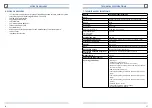
12
13
IMPORTANT NOTES
IMPORTANT NOTES
1.8. Site location
BEFORE SETTING UP THE MICROSCOPE: select a suitable location.
Place the microscope on a resistant surface away from strong sunlight, heat sources,
high humidity, high dust exposure as well as strong vibration.
•
The ambient temperature range of the microscope is 5°C to 40°C (41°F to
109°F)!
• If the device is exposed to temperatures outside this range, this will cause
irreparable damage to optical and/or mechanical parts which are not
covered by warranty.
• Place the microscope on a surface that meets the following criteria:
› Flat
› Vibration-free
› Level
›
Hard surface and non-flammable
›
Stable (the unit weighs approximately 10.5 kg)
• Chemical and mechanical resistant
• Place the microscope so that:
› There is at least 10 cm clearance around the device or to other devices or the
wall.
› You can disconnect it from the mains at any time.
• The mains cable must be freely accessible at all times, as the mains cable is inten-
ded as a disconnecting device from the mains.
• Make sure the residual moisture is fully eliminated before use.
• For use in warm and humid climates, all optical components of the microscope
are already equipped with protection against fungus infestation.
1.9. Cleaning/maintenance/transport
IN THE EVENT OF A LONG OPERATING INTERRUPTION
and especially
maintenance and cleaning work, disconnect the power supply by pulling out
the mains plug.
BEFORE EVER CLEANING:
Dismantle optical elements (e.g. objective, eye-
piece, etc.).
BEFORE USING THE MICROSCOPE:
The residual moisture should be com-
pletely removed.
DO NOT USE ORGANIC SOLVENTS
(e.g. alcohol, ether, acetone, xylol or
other dilutions) to clean lacquered parts or plastic parts!
ALCOHOL IS HIGHLY FLAMMABLE!
AVOID DAMAGE TO THE ELECTRONICS:
by not using cleaning fluid.
1
1
IF YOU USE PREPARATIONS
that pose a potential risk of infection, all parts
that have come into contact with the preparation must be thoroughly cleaned.
The PLAN APO 1x objective, the zooming body, the coarse/fine focusing
mechanism and the aperture diaphragm are precisely designed and matched
to each other. Please avoid disassembling the components. This will affect the
performance of the microscope.
TRANSPORT:
Please remove all loose parts (e.g. glass plate, eyepieces)
and the object to be observed from the glass plate. Only use the original
packaging for transport.
Cleaning microscope body / optical elements
• Only use a dry cloth to clean the exterior of the device.
• BEFORE CLEANING: Disassemble optical elements (e.g. objective, eyepiece, etc.).
•
Blow away loose dust from the lens surfaces first.
•
Use a soft disposable paper cloth soaked in 30%-70% pure alcohol (available at
the pharmacy or drugstore). Do not apply the cleaning solution directly to the
optical parts. Gently wipe the lens surface by cleaning the surface with circular
movements from the centre to the edge of the optic. Apply light pressure to the
optics while doing this.
1.10. Protection and storage
• PROTECT THE DEVICE against dust and moisture.
• AVOID PUTTING FINGERPRINTS and equal contaminations on any optical surfa-
ces.
• PULL A DUST PROTECTION COVER OVER THE MICROSCOPE. Before covering the
microscope, always check that the microscope is also switched off.
• IT IS RECOMMENDED to store this microscope in a protected place where there
are no acid gases, alkalis, organic solvents and other harmful substances in the
vicinity.
• STORE THE MICROSCOPE in a closed container at a dry and mould-free place.
• STORE THE MICROSCOPE AND THE ACCESSORIES in the relevant containers
when they are not used for a longer time.
• IT IS RECOMMENDED to store also the objective and the eyepieces in closed con-
tainers with desiccant.
A dust protection cover is included in delivery.
REMEMBER:
A well maintained microscope will keep its optical quality for
years and thus maintain its value.







































